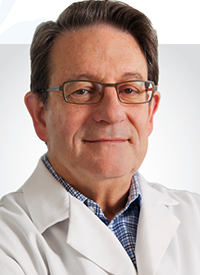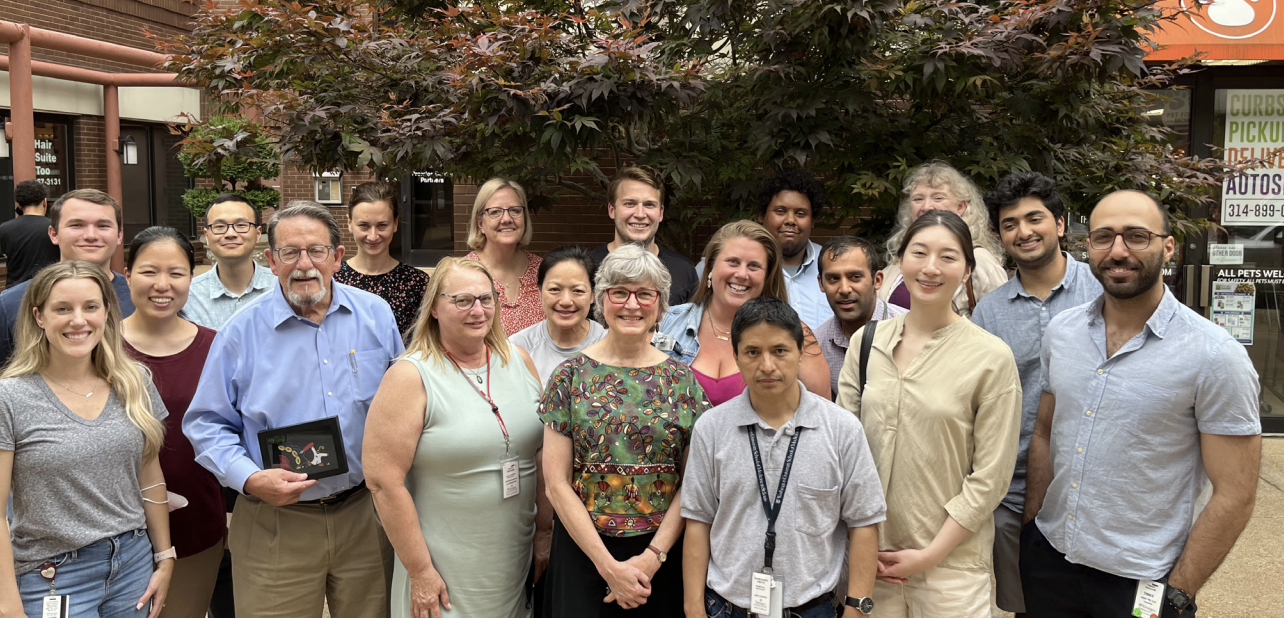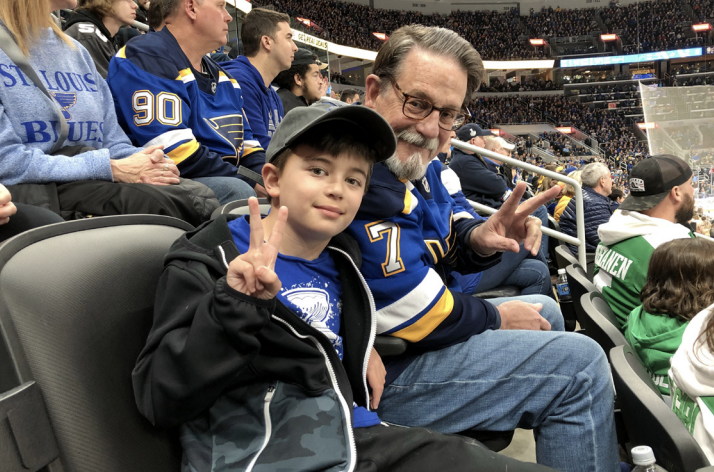DiPersio’s Altered Career Path Led to Groundbreaking Developments in Leukemia
A teenage injury cost him a career among the stars, so John F. DiPersio, MD, PhD, became a star hematologist/oncologist instead.
John F. DiPersio, MD, PhD

As a young man, John F. DiPersio, MD, PhD, was fixated on traveling to the stars. Between his father’s work in the United States Air Force and his own early infatuation with aeronautics and astrophysics, DiPersio imagined a career at NASA among the heavens.
Growing up in and around Boston, Massachusetts, another pastime naturally piqued his childhood interest: hockey. DiPersio picked up the sport at a young age and played both high school and NCAA college hockey.
DiPersio’s love for the sport, though, drastically altered the trajectory of his professional career. In the time before visors and face shields became standard equipment for high school players, a rogue puck to the face cost DiPersio his left eye. He lost vision in his left eye and, with it, any chance of becoming a pilot or entering the space program.
“I was injured twice, both times playing hockey, so I was an idiot [and kept playing],” DiPersio laughed. “I had a damaged eye to start with. I went back to playing...and then [my vision] got completely squashed and required some surgery just to save my eye but not my vision unfortunately.
“It takes a little while to get used to seeing out of one eye, but you do get used to it. Your brain adapts over time,” DiPersio continued. “I did have a little problem with depth perception. I still do. But your brain is amazingly adaptable. It took me probably a year to really feel comfortable driving and doing all the things I’m supposed to do.”
DiPersio’s adaptation to living with one functioning eye would not revive his pursuit of working for the nation’s space program. However, NASA’s loss turned into oncology’s gain.
Matters of the Marrow
DiPersio gravitated toward biology during his first year as an undergraduate at Williams College, paving his way toward the medical field. The aspects and functions of bone marrow fascinated him to the point where he focused his senior thesis on the blood-forming system of bullfrogs.
Although he was laying groundwork for a career specializing in hematology, DiPersio left his options open when he entered medical school at the University of Rochester in New York. A summer rotation with Marshall A. Lichtman, MD, who would become his mentor, firmly pointed him toward a career centered in molecular biology and hematopoiesis. Lichtman, who eventually became the president of the American Society of Hematology, served as the chief of the university’s Division of Hematology.
Under DiPersio’s leadership, the Division of Oncology at Washington University School of Medicine in St Louis, Missouri, has grown from 4 faculty members to more than 150, making it one of the largest university oncology departments in the world.

“I was approaching the clinical years in my medical school career, and I decided to leave,” DiPersio said. “I stayed in [Lichtman’s] lab to do a PhD in hematology and focused on factors that enhanced the expansion of myeloid cells on neutrophils and monocytes.”
DiPersio received both his medical degree and a PhD in microbiology from the University of Rochester in 1980. As a physician, DiPersio became board certified in hematology and oncology. His interests spurred him toward additional research into the functions of T cells and stem cells.
His investigations led to the development of the hematopoietic stem cell mobilizer plerixafor (Mozobil), which was approved by the FDA in 2008 for the treatment of multiple myeloma and non-Hodgkin lymphoma. The agent mobilizes hematopoietic stem cells from the bone marrow into the bloodstream where they can be collected, increasing the chances for patients with these diseases to receive potentially curative stem cell transplantation. What started as a professional interest turned into an obsession that added a key agent to the treatment paradigm in those diseases. His later basic science studies focused on the role of JAK1/JAK2 inhibition for the prevention and treatment of acute graft-vs-host disease (GVHD). These studies led to the FDA approval of ruxolitinib as the first and only drug for the treatment of steroid refractory acute GVHD.
“I spent probably most of the past 25 years performing translational studies to enhance our understanding of the [bone marrow] niche and ways of actually inducing the release of stem cells into the blood, optimizing the clinical benefit of stem cell transplantation for the treatment of acute leukemias including reducing GVHD, targeting leukemia cells with immunotherapy such as chimeric antigen receptor (CAR) T cells, gene-edited (CRISPR) CAR T cells, and genetic modification of stem cells for the treatment of inherited diseases of the bone marrow such as sickle cell anemia,” DiPersio said.
Those breakthroughs didn’t happen overnight for DiPersio. Early in his working life, he struggled to gain momentum in the competitive hematologic field. Some out-of-the-box thinking shifted his career trajectory.
“I was sort of working by myself in a small lab. I was competing with lots of big groups around the world, and I felt that I may not have been doing as well as I could,” DiPersio said. “I started thinking about different directions.
“One of the directions I was interested in was understanding the biology of the hematopoietic niche, and how stem cells get there and how they get out of there.”
After completing his residency at Parkland Memorial Hospital of UT Southwestern in Dallas, Texas, DiPersio went to the University of California, Los Angeles (UCLA) School of Medicine in 1984 as a fellow in the Division of Hematology-Oncology. His mentors at UCLA—David Golde, MD, and Judith Gasson, PhD—opened the door to his academic career. He became an assistant professor of medicine at UCLA in 1988. Next, DiPersio spent time in the Northeast as an assistant professor of oncology at his alma mater, the University of Rochester School of Medicine and Dentistry.
An opportunity then arose at Washington University in St Louis, Missouri. The institution was less established than it is today, but DiPersio took a position as an associate professor of medicine, pediatrics, pathology, and immunology in 1994.
The DiPersio family with the Stanley Cup following the St Louis Blues’ first NHL championship in 2019, from left: John, Jack, Allison King MD, PhD, MPH, and Isabella.

What started out as a small laboratory operation and Division of Oncology at Washington University has turned into one of the largest divisions of oncology in the world and ranks among DiPersio’s proudest accomplishments. When he arrived, he was 1 of just 6 faculty members in oncology. Now, he has over 150 faculty in the Division of Oncology at the institution.
The work done by DiPersio and his coresearchers wasn’t accomplished without its share of adversity. Even today, he finds that he must continue to push the validity of gene therapy in the oncology field and the key importance of both basic and clinical research to provide the best care possible for patients with cancer. “There have been a lot of people over the years who still don’t think [gene therapy] is healing cancer,” DiPersio said. “There are a lot of biases. It’s hard to get funded, but we’ve been able to do it because we’ve done some good work and we have leaders in the field.”
DiPersio, here with his son, Jack, at a Blues game. DiPersio played hockey in college, but an eye injury ended his career.

Although the economics of cancer care has become a supreme focus of hospitals and medical schools, DiPersio often reminds his faculty to focus on the research. “We ain’t in no private practice here,” he said. “No true progress can be made without research.”
The Hematologic Power Couple
DiPersio’s professional life wasn’t the only thing to thrive in St Louis. He also met his future wife, Allison King, MD, PhD, MPH, a pediatric hematologist and oncologist and a professor of pediatrics, hematology and oncology, occupational therapy, surgery, and education at Washington University.
King has a professional background similar to her husband’s, with her research focusing on issues relating to improving outcomes and granting access to care for patients with sickle cell anemia. “She’s really a highly productive implementation scientist and a true star in the field,” DiPersio said. “Her goal is to build a world-class sickle cell research program here at Washington University School of Medicine.”
DiPersio and King have 11-year-old twins, Jack and Isabella. While trying to balance his continued research and work, DiPersio is also trying to navigate the transition to raising a pair of soon-to-be teenagers.
“They both love their electronics,” DiPersio laughed. But the family gets outside plenty, sharing bike rides and simply enjoying one another’s company.
Even with his busy professional and personal life, DiPersio still makes time for his own interests. “I love art, supporting the local art community, visiting art galleries and modern art museums, mostly. And I’m a doodler myself…I’ve even sold a few things,” DiPersio said.
“I have 2 other passions,” DiPersio added. “Good champagne and great jazz. Both together might even be better.”
DiPersio’s favorite artist is 20th-century Austrian Friedensreich Hundertwasser, a painter, architect, ecological activist, and philosopher known for his paintings and graphic designs centered on spirals and arabesque lines. Hundertwasser referred to a straight line as “a curse of our civilization,” elaborating that it is “something cowardly drawn with a rule, without thought or feeling; it is a line which does not exist in nature.”
“He was really a character. He was bizarre, but I love bizarre,” DiPersio said.
DiPersio with his children, Jack and Isabella. They “love their electronics,” but he likes to get them outside whenever he can.

DiPersio’s favorite jazz artists include John Coltrane, Horace Silver, and McCoy Tyner with “A Song For My Father” by Horace Silver being his alltime favorite jazz tune. “I drive my kids crazy with my love for jazz, and I love torturing them.”
DiPersio hasn’t lost his passion for hockey, either. Growing up, he sat near the rafters at the old Boston Garden to cheer on the Bruins. His allegiance has since shifted, he admitted, to the St Louis Blues, his adopted hometown team, and his clashes of commitment culminated in 2019 when the Bruins met the Blues in the Stanley Cup Final. Winning the last game of the best-of-7 series, the Blues captured their first championship in franchise history.
“It was fantastic,” DiPersio said. “It was almost 50 years after the Blues lost to the Bruins in 1970 in the Stanley Cup Final with my old hero Bobby Orr, the only other time they had been there.”
The Journey Is Just Beginning
DiPersio’s laundry list of professional accomplishments would be enough to make anyone proud, but he’s not even close to calling it a career. He’s still pushing the boundaries to research novel ways to treat hematologic malignancies.
His laboratory focuses on exploring novel agents including CAR T cells and targets in multiple myeloma, and he has put an emphasis on research for graft-vs-host disease. DiPersio is investigating the novel CXCR4 motixafortide (BL-8040) in clinical trials for several indications, including pancreatic cancer and acute myeloid leukemia. The FDA granted the agent an orphan drug designation for pancreatic cancer in 2020. DiPersio said the research conducted at Siteman Cancer Center over the past 2 years will likely result in the FDA approval of this drug.
DiPersio shares a moment with his son, Jack.

He is the senior author for the phase 3 GENESIS trial evaluating motixafortide plus granulocyte colony-stimulating factor (G-CSF) in patients with multiple myeloma. The combination induced a 4.9-fold increase in achieving target stemcell mobilization for autologous bone marrow transplantation in up to 2 apheresis sessions vs G-CSF. Almost 90% of patients in the study proceeded to transplantation after only 1 apheresis session.
“Our team did a lot of the science and led the clinical trials with [motixafortide],” DiPersio said. “In our lab, we also have a group who works on identifying novel mobilizing agents, and we’ve generated some [leading] compounds that are VLA-4 inhibitors. They are small molecules, and we’re very excited about these. They act synergistically with CXCR4 inhibitors for rapid mobilization.”
For him, the best part of this project is that one of his protégés, Zachary D. Crees, MD, led the research. “Trainees doing big stuff. Well, it does not get better than this,” DiPersio exclaimed.
DiPersio is also the co-founder of 2 thriving biotech companies; Magenta Therapeutics, a Boston-based stem cell biology company with more than 500 employees and Wugen Inc, a gene and cell therapy biotech with more than 100 employees. Both have products in clinical trials for the treatment of patients with cancer.
DiPersio stressed that he is not the sole driving force behind all of his lab’s ongoing work. None of the group’s advancements or future research would have been possible, he noted, without the ever-growing roster of colleagues joining the fold at Washington University.
On top of the research that the university has supported, DiPersio and colleagues have been able to shift patient care at the institution for the better.
“We were seeing about 300 new patients a year when I came here, and now we see about 10,000 new patients a year,” DiPersio said. “It’s complicated, helping to build a division and NCI Comprehensive Cancer Center while keeping everybody together and moving forward these days. Living within these academic systems where there are lots of holes and tugs for resources or oversight for control, we have been able to keep everybody engaged, growing, and happy, and we’re doing great work for patients.”



